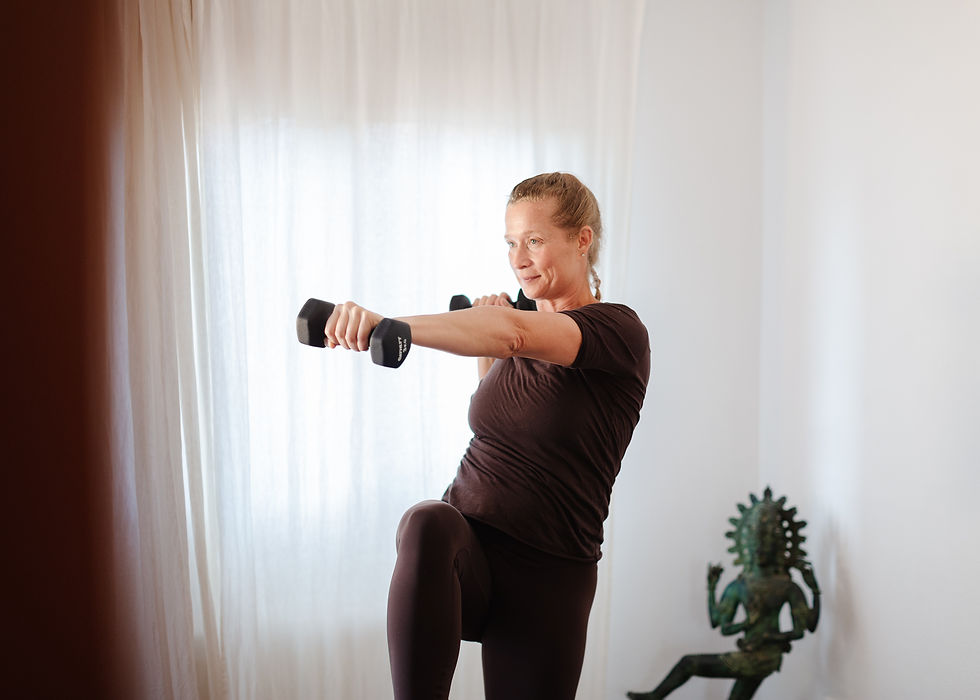Is Yoga Enough After 40?
- Shaini Verdon
- Sep 3
- 5 min read
Updated: Sep 8
For many years, yoga was my home. It was my daily practice, my anchor, and my way of understanding my body. I especially gravitated toward Iyengar yoga, with its precision, its alignment, and its deep holds. I loved the sense of order in it, the discipline of staying still in a pose and refining it until the body felt like a perfectly tuned instrument.
And yet… over time, something in me began to resist.
Even though many of my dear colleagues still swear by Iyengar yoga (and I deeply respect them), it stopped feeling right for my body. The longer holds, the deep stretches, the pushing into end ranges — it no longer gave me energy, strength, or ease. Instead, it started to feel like my body was fighting back. I experienced discomfort in my joints, tension in places that should have felt open, and a general sense of being “less strong.”
If you’ve ever loved yoga but started to feel that something is off in your 30s or 40s, this might resonate with you. Many women begin to wonder: is yoga enough after 40? Keep reading, because I want to explain what changed for me — and why this shift can be important once hormones begin to fluctuate.

What Changes in Women’s Bodies After 35–40
Most women don’t realise how much changes beneath the surface after 35. Hormones don’t just regulate cycles — they influence muscles, bones, fascia, and connective tissue.
Estrogen begins to fluctuate → Estrogen supports collagen and fascia, keeping tissues elastic and hydrated. As levels dip, tissues become stiffer, less resilient, and more prone to micro-damage. This is exactly why long passive stretching can backfire: instead of tissues adapting, they may overstretch or even micro-tear. Without estrogen’s cushioning effect, ligaments and fascia don’t “bounce back” the way they once did, and the nervous system often reads passive pulling as unsafe — leaving the body more tense afterwards, not less.
Muscle mass declines faster → Sarcopenia (age-related muscle loss) starts earlier than most expect, with up to 1% lost per year after 40 without resistance training.
Bone density decreases → Especially in perimenopause, bones need load to stay strong. Yoga alone rarely provides enough.
Tendons and fascia remodel → With less hormonal support, connective tissues don’t tolerate passive overstretching well.
Nervous system sensitivity increases → Long passive holds or high-repetition flows can trigger protective tension, sometimes leaving you more sore than supple.
This is why the yoga practice that once felt perfect in your 20s may start to feel uncomfortable — or simply less effective — in your 40s.

Yoga and Static Flexibility
Yoga comes in many forms, and every style offers something valuable. At its core, most yoga emphasises static flexibility — holding a position for time, whether passively or actively.
Yin yoga → designed to be passive, with long holds (3–5 minutes) where gravity and props do the work. This relies more on connective tissues than muscular engagement.
Iyengar yoga → precise and aligned, often held for longer durations. These holds demand strong muscular activation (active static stretching), even while the shape itself looks still.
Ashtanga, Vinyasa, and Power yoga → appear more dynamic because of their transitions, but many postures involve strong active static holds at end ranges.
For some women, these approaches continue to feel supportive and nourishing well into midlife. But for others — myself included — as hormones shift and tissues change, the static emphasis (whether passive or active) can start to feel less stable or even uncomfortable.
Dynamic & Loaded Stretching + Resistance Training: The Missing Link
This is where dynamic stretching, loaded stretching, and resistance training come in.
Dynamic stretching → moving into and out of a range with strength and control. Muscles contract concentrically, eccentrically, and isometrically to support the joint while the body flows through range.
Loaded stretching → adding external load (weights, bands, kettlebells) to strengthen muscles and bones in lengthened positions, building resilience in fascia and connective tissues.
Resistance training → challenging muscles and bones progressively with load, creating adaptations that keep us strong and stable as we age.
Example: The Low Lunge
Passive version: Drop in, sink hips toward the floor, hold. Hip flexors stretch, but the lumbar spine and hip capsule take strain.
Dynamic version: Step in, gently pulse in and out, keeping glutes and quads engaged. Suddenly it’s not just a stretch — it’s mobility training and joint protection.
Loaded version: Perform the same lunge while holding a weight, building strength at length and stimulating fascia and bone.
That shift — from “hanging” to “building” — is profound. It’s why dynamic and loaded stretching, alongside resistance training, feel so much better after 40.
How I Teach It in SoulSculpt
Every SoulSculpt class weaves these principles:
Strength first → weights, resistance, and bodyweight load to give bones and muscles the challenge they need. Here I use the principle of progressive overload — gradually increasing the challenge over time, whether that’s by adding repetitions, slowing the tempo, or layering more complex variations. This keeps the body adapting and building strength.
Dynamic and loaded stretching → pulses, repetitions, and end-range work with or without load. Here I emphasise time under tension — keeping muscles engaged for longer while moving through range. This builds strength through length, protects joints, and nourishes fascia, making it more resilient and elastic.
Gentle passive release at the end → not as the main event, but as integration, calming the nervous system and allowing the body to absorb the work.
This way, SoulSculpt isn’t just about flexibility or strength — it’s about combining them intelligently, in a way that feels supportive, sustainable, and deeply effective for women after 40.
My Turning Point
This realisation changed everything for me.
I didn’t want to be bendy anymore — I wanted to be resilient. Strong but supple. Mobile but stable.
Passive stretching left me sore. Flow yoga left me depleted. Dynamic and loaded stretching combined with resistance training left me powerful, energised, and at ease.
That’s why I created SoulSculpt: a practice that blends strength training, Pilates, yoga, and somatic awareness. It honours what women’s bodies need after 35–40: strength through range, fascia resilience, and nervous system support.

So, Is Yoga Enough After 40?
For some women, yes — yoga continues to feel deeply nourishing and complete. But for many of us, myself included, yoga alone no longer provides everything our bodies need after 40.
Once hormones shift, we often need more: progressive overload, time under tension, and dynamic + loaded stretching to stay strong, supported, and resilient.
If your yoga practice still feels right, wonderful — keep honouring it. And if it doesn’t, know that there are other options available.
Practice With Me
This is why I teach SoulSculpt every week:
Online classes accessible anywhere.
In-person classes here in Cantabria, Spain.
Women’s retreats where we go deeper into movement, nourishment, and sisterhood.
Together, we practice in a way that honours the changes after 40 — and gives you tools to feel stronger, freer, and more at home in your body.
✨ Closing thought: Yoga can open the window, but strength and active flexibility build the house. After 40, choose the house.
With love,
Shaini



Comments